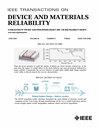基于热均衡分析的 3D 集成电路布线优化
IF 2.5
3区 工程技术
Q2 ENGINEERING, ELECTRICAL & ELECTRONIC
IEEE Transactions on Device and Materials Reliability
Pub Date : 2024-03-08
DOI:10.1109/TDMR.2024.3374231
引用次数: 0
摘要
三维集成电路(3D IC)具有性能优势,因为它减少了布线,克服了二维集成电路的缺点,并使用一种称为硅通孔(TSV)的重要结构垂直连接相邻层。然而,三维结构不可避免地会导致热问题,三维集成电路中不良的布线管理会导致三维集成电路芯片热应力的增加和系统稳定性的下降。本文在热均衡的基础上,结合布局设计,对芯片-硅片互插板-印刷电路板(PCB)组装结构进行了仿真分析,研究了布局、焊球选择和 TSV 布局对 3D IC 布局布线的影响。仿真结果表明,我们的布线优化方法可优化热应力,减少局部大变形,降低温度,提高系统稳定性。本文章由计算机程序翻译,如有差异,请以英文原文为准。
Optimization of 3-D IC Routing Based on Thermal Equalization Analysis
Three-dimensional integrated circuits (3D ICs) offer performance advantages due to their reduced wiring overcomes the drawbacks of 2D IC and a vital structure called through-silicon via (TSV) is used to connect the adjacent layers vertically. However, the 3D structure will inevitably lead to thermal issues, and poor routing management in 3D ICs will lead to the increase of thermal stress in 3D IC chips and the deterioration of system stability. In this paper, based on thermal equalization, the chip-silicon interposer-printed circuit board (PCB) assembly structure is simulated and analyzed combined with layout design to investigate the impact of layout, solder ball selection, and TSV layout on the routing of 3D IC layout. The simulation results demonstrate our routing optimization method achieves optimized thermal stress, less large local deformation, reduced temperature, and higher system stability.
求助全文
通过发布文献求助,成功后即可免费获取论文全文。
去求助
来源期刊

IEEE Transactions on Device and Materials Reliability
工程技术-工程:电子与电气
CiteScore
4.80
自引率
5.00%
发文量
71
审稿时长
6-12 weeks
期刊介绍:
The scope of the publication includes, but is not limited to Reliability of: Devices, Materials, Processes, Interfaces, Integrated Microsystems (including MEMS & Sensors), Transistors, Technology (CMOS, BiCMOS, etc.), Integrated Circuits (IC, SSI, MSI, LSI, ULSI, ELSI, etc.), Thin Film Transistor Applications. The measurement and understanding of the reliability of such entities at each phase, from the concept stage through research and development and into manufacturing scale-up, provides the overall database on the reliability of the devices, materials, processes, package and other necessities for the successful introduction of a product to market. This reliability database is the foundation for a quality product, which meets customer expectation. A product so developed has high reliability. High quality will be achieved because product weaknesses will have been found (root cause analysis) and designed out of the final product. This process of ever increasing reliability and quality will result in a superior product. In the end, reliability and quality are not one thing; but in a sense everything, which can be or has to be done to guarantee that the product successfully performs in the field under customer conditions. Our goal is to capture these advances. An additional objective is to focus cross fertilized communication in the state of the art of reliability of electronic materials and devices and provide fundamental understanding of basic phenomena that affect reliability. In addition, the publication is a forum for interdisciplinary studies on reliability. An overall goal is to provide leading edge/state of the art information, which is critically relevant to the creation of reliable products.
 求助内容:
求助内容: 应助结果提醒方式:
应助结果提醒方式:


